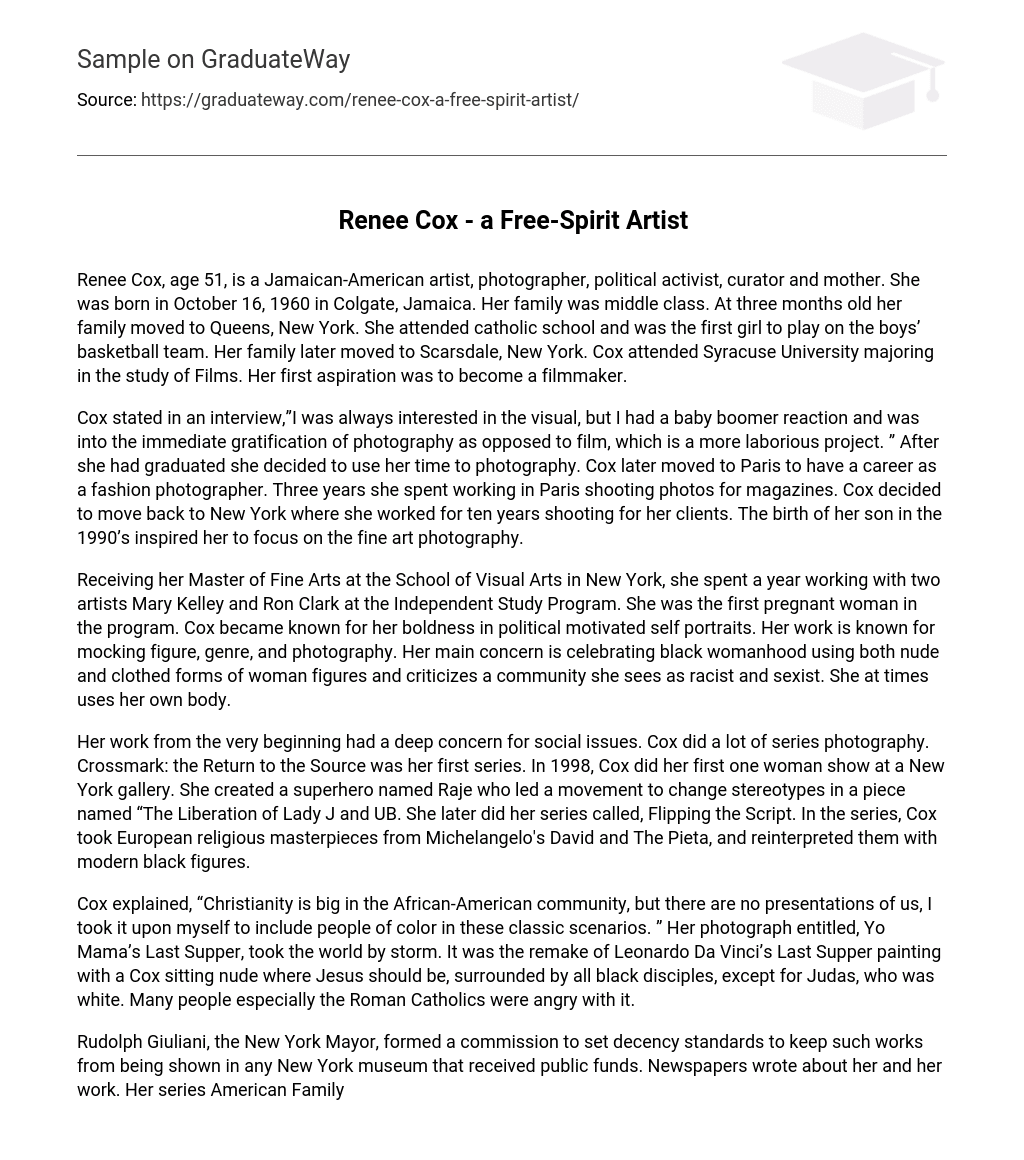Renee Cox, age 51, is a Jamaican-American artist, photographer, political activist, curator and mother. She was born in October 16, 1960 in Colgate, Jamaica. Her family was middle class. At three months old her family moved to Queens, New York. She attended catholic school and was the first girl to play on the boys’ basketball team. Her family later moved to Scarsdale, New York. Cox attended Syracuse University majoring in the study of Films. Her first aspiration was to become a filmmaker.
Cox stated in an interview,”I was always interested in the visual, but I had a baby boomer reaction and was into the immediate gratification of photography as opposed to film, which is a more laborious project. ” After she had graduated she decided to use her time to photography. Cox later moved to Paris to have a career as a fashion photographer. Three years she spent working in Paris shooting photos for magazines. Cox decided to move back to New York where she worked for ten years shooting for her clients. The birth of her son in the 1990’s inspired her to focus on the fine art photography.
Receiving her Master of Fine Arts at the School of Visual Arts in New York, she spent a year working with two artists Mary Kelley and Ron Clark at the Independent Study Program. She was the first pregnant woman in the program. Cox became known for her boldness in political motivated self portraits. Her work is known for mocking figure, genre, and photography. Her main concern is celebrating black womanhood using both nude and clothed forms of woman figures and criticizes a community she sees as racist and sexist. She at times uses her own body.
Her work from the very beginning had a deep concern for social issues. Cox did a lot of series photography. Crossmark: the Return to the Source was her first series. In 1998, Cox did her first one woman show at a New York gallery. She created a superhero named Raje who led a movement to change stereotypes in a piece named “The Liberation of Lady J and UB. She later did her series called, Flipping the Script. In the series, Cox took European religious masterpieces from Michelangelo’s David and The Pieta, and reinterpreted them with modern black figures.
Cox explained, “Christianity is big in the African-American community, but there are no presentations of us, I took it upon myself to include people of color in these classic scenarios. ” Her photograph entitled, Yo Mama’s Last Supper, took the world by storm. It was the remake of Leonardo Da Vinci’s Last Supper painting with a Cox sitting nude where Jesus should be, surrounded by all black disciples, except for Judas, who was white. Many people especially the Roman Catholics were angry with it.
Rudolph Giuliani, the New York Mayor, formed a commission to set decency standards to keep such works from being shown in any New York museum that received public funds. Newspapers wrote about her and her work. Her series American Family is displayed at the Robert Miller Gallery along with her series Queen Nanny of the Maroons. The series was shown at the Jamaican Biennial viewed at the National Gallery of Jamaica in 2006. Cox’s work was awarded the highest honor any artist in Biennial has ever gotten called the Aaron Matalon Award.
I chose Cox because she is a perfect example of what it means to be an artist. She was a free-spirit and did not let anyone deter her from doing what she believes in. To this day she continues to question society and their believe about black women. Her work reaches out to my soul and speaks to me. She was a feminist artist that believes women to be of importance to society. Cox gives me another way at looking at the arts and is a huge inspiration to me.





